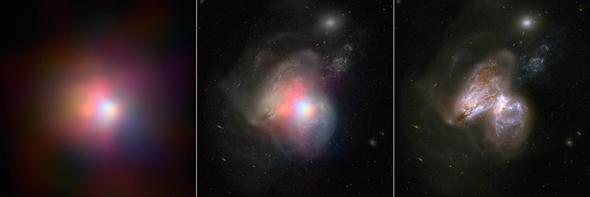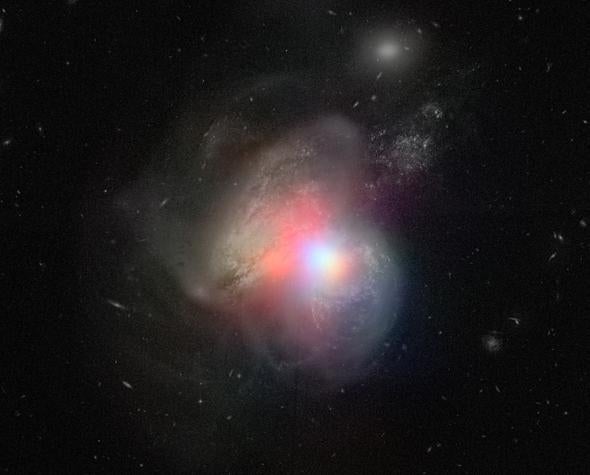When whole galaxies collide, it’s a train wreck on a cosmic scale.
Usually there’s a near miss first, with each galaxy flying past the other. Both galaxies get distorted, their mutual gravity stretching them like taffy. They pull apart, but then their mutual gravity draws them together again, and the collision begins for real. What may have started as two lovely spiral or elliptical galaxies becomes chaos, the stars and gas clouds flung this way and that, and the resulting coalescing object a lumpy mess.
Eventually the two galaxies merge. We know that all big galaxies have supermassive black holes in their cores, millions and even billions of times the mass of the Sun. After two galaxies collide, eventually their central black holes collide and merge as well, forming a bigger black hole (and blasting out gravitational waves). But that doesn’t happen for quite some time; during the actual galaxy collision each black hole is its own entity.
Not only that, but gas clouds tossed about by the collision can drop into the center of each galaxy, doomed to fall into the black hole there. When they do, the material piles up into a disk just at the edge of forever, swirling madly, heating up, and blasting out X-rays.
Which brings us to Arp 299, a pair of gorgeously colliding galaxies about 140 million light-years from Earth. We know that the collision has been going on a while; the system glows brilliantly in infrared, putting out almost a trillion times the Sun’s energy output just in that one wavelength! That’s due to huge amounts of dust around their black holes, which absorbs a lot of the energy, gets warm, and re-emits it in the infrared.
The cores of the two galaxies are separated by less than 15,000 light-years, which is pretty close on a galactic scale. That’s interesting, but it’s also irritating to astronomers: They’re so close together it’s been difficult to separate them using X-ray telescopes. And we know they’re emitting copious X-rays; the problem is knowing which black hole is emitting what.

NASA/JPL-Caltech/GSFC
Now, though, they’ve been teased apart. Using both NuSTAR and Chandra—two orbiting X-ray observatories—astronomers have figured out what each black hole is doing. In the image above, it’s the one on the right (Arp 299B) that’s pouring out X-rays, and is what we call an Active Galactic Nucleus, or AGN. The galaxy on the left (Arp 299A) is also emitting X-rays, and might be an AGN as well, but it’s only contributing about 10 percent of the total X-ray emission of the system.
The energy of the X-rays Arp 299A is emitting is also consistent with it having lots of what are called high-mass X-ray binaries (or HMXB), which consist of a high-mass star orbiting a black hole. In this case, the black hole in a HMXB is far smaller than the ones in the centers of the galaxies; it may have a few times the Sun’s mass, not millions of times. But it’s enough to draw material off its companion star, which then (like its supermassive counterpart) creates a disk of material that heats up and emits X-rays. But the way these emit rays is different then the cores of AGN, making it possible to distinguish between them (in general HMXB emit much higher energy X-rays than AGN).
Well, sometimes. In the case of Arp 299 it’s hard to be sure; the observations aren’t distinct enough to be certain Arp 299A is not an AGN. The astronomers who observed the system mention they plan on observing lots of other galaxies in this same way, specifically galaxies that are known to be rapidly forming stars. These tend to have more HMXBs in them, and that will act as a benchmark, helping astronomers distinguish between AGN and HMXB. The more “starburst” galaxies observed, the easier it will be to understand colliding ones as well.
All of this underscores a very important aspect of astronomy, science, and really just life in general: You have to observe things in more than one way to understand them. Using telescopes like Hubble or other big optical-light observatories is great, but they only give you part of the picture (literally), only tell part of the story.
Changing your viewpoint gives insight and perspective. That sounds like pretty good advice to me, whether you’re thinking about something scientifically or exercising a little bit of human compassion. In my opinion, we could use a lot more of both.
